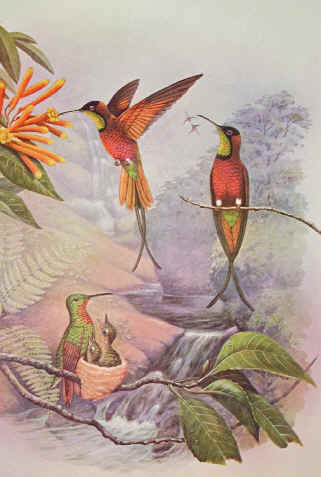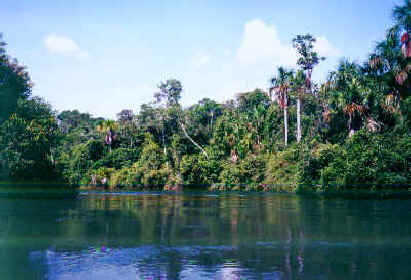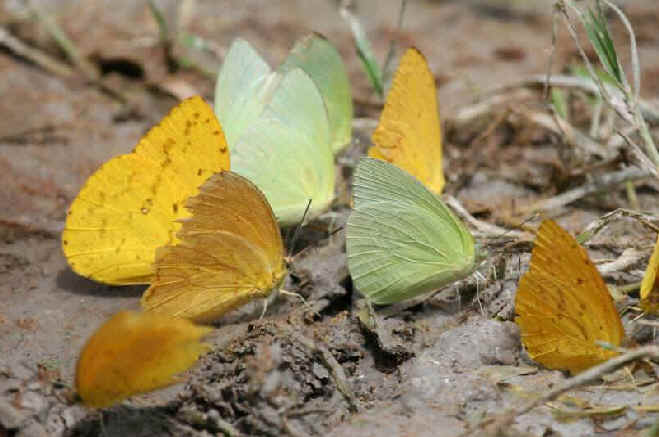
E-mail: font@focusonnature.com
Phone: Toll-free in USA 1-888-721-3555
or 302/529-1876
 |
PO
Box 9021, Wilmington, DE 19809, USA E-mail: font@focusonnature.com Phone: Toll-free in USA 1-888-721-3555 or 302/529-1876 |
A FOCUS ON NATURE TOUR
in
Brazil
IN
RONDONIA
and aMAZONAs
For Birds, Butterflies,
Mammals, and Other Nature
October 23 - November 1, 2015
(tour: FON/BR–5 '15)

This
itinerary, given below, is followed
by a listing of some "Amazonian birds",
with those endemic to Brazil,
and those that are specialties of the region of Manaus ,
and others of interest that occur there.
One of the specialties is the hummingbird,
known as the Crimson Topaz,
pictured above.

Links:
A
List & Photo Gallery of Brazil Birds, in 4 parts:
Part #1: Tinamous to Doves
Part #2: Macaws to Flycatchers
Part #3: Antshrikes to Woodcreepers Part
#4: Vireos to Grosbeaks
Mammals & Some Other Wildlife of Brazil (with some photos)
A List & Photo Gallery of South America Butterflies, in 5 parts (with some photos)
Highlights of some Previous FONT Tours in Brazil
The Basic Itinerary (price follows):
![]()
Price: US $2,895 per person, based upon double occupancy.
Single supplement: US $295.
Price includes:
All overnight accommodations.
All meals (from Oct 23 to Oct 31).
Ground transportation within Brazil (land & boat).
Fees & permits for forested areas & reserves to be visited.
Services of the FONT birding leader.
Prices do not include: Drinks and other items of a personal nature. Gratuities. Air transportation to/from & within Brazil.
"Focus On Nature Tours"
can arrange air travel,
seeking the best possible fares.
A deposit of US $500 is required to register for the tour.
![]()
From the book, "River of Doubt":
There is a fine book relating the
story of how the
Rio Roosevelt
in Amazonian Brazil came to be called that, and
describing the journey there by the former US president Theodore Roosevelt
in the early 20th Century. That book is entitled "The River of Doubt",
by Candice Millard, and it is well worth the read, even if one never goes there,
but especially if one does.
The "River of Doubt", as Millard calls it, or the Rio
Roosevelt,
as it came to be known, was, according to the jacket of the book,
"black and uncharted, snaking through one of the most treacherous jungles
in the world. Indians armed with poison-tipped arrows haunted in the shadows,
piranhas glided through its waters (and still do), and boulder-strewn rapids
turn the river into a roiling cauldron.
After his humiliating election defeat in 1912, Theodore (or Teddy) Roosevelt set
his sights on the most punishing physical challenge he could find, the first
descent of an unmapped, rapids-choked tributary of the Amazon River.
Together with his son Kermit, and Brazil's most famous explorer, Candido Mariano
da Silva Rondon, Roosevelt accomplished a feat so great that many, upon his
return home, refused to believe it.
Along the way, Roosevelt and the men with him faced an unbelievable sequence of
hardships, losing their canoes and supplies to punishing whitewater rapids, and
enduring starvation, Indian attack, disease, drowning, and a murder within their
own ranks. Three men died, and Roosevelt himself was at the brink."
THE FOLLOWING TEXT IS PARAPHRASED FROM THE BOOK, THE ''RIVER OF DOUBT'':
Although they had risen well before dawn, it was almost noon by the time
Roosevelt, the outdoorsman George Cherrie, and Dr. Jose Cajazeira, and their
three paddlers finally climbed into their dugout on the morning of February 28,
1914, and headed off down the river in pursuit of the rest of the expedition,
which had left camp nearly 4 hours earlier.
Sympathetic to how difficult it had been, and likely would continue to be, for
the naturalists (Cherrie & Cajazeira) to collect specimens for the museum
while they were on the River of Doubt, Roosevelt had directed the other two
dugouts and two balsas to go ahead without them when Cherrie heard some
birdcalls near camp that morning.
Cherrie had made it worth Roosevelt's while, capturing six birds, including a
large "red-headed" woodpecker and a brilliant turquoise-blue
cotinga.
Once back on the twisting river, Roosevelt and Cherrie
resumed their search for signs of life. Their efforts were rewarded by an otter
splashing in the river, and two tropical birds called guans.
With his face east in shadow beneath his deep sun helmet, Roosevelt watched as
the jungle glided past him, with its towering trees and blue-sky reflected, like
a trembling inverted world, in the water's dark surface. He drank in the rich
array of beauty, admiring the many brightly-colored butterflies that
"fluttered over the river", and marveled at how a spark of sunlight
could cloak the electric green jungle. "when the sun broke through rifts in
the clouds," he wrote, "his shafts turned the forest to
gold."

Butterflies
photographed during a FONT tour in Brazil
As Roosevelt, and the others, paddled quietly down the river, a long, deep roar
suddenly erupted through the jungle. It was the voice of a Howler Monkey, one of
the loudest sounds of any animal on earth. It can be heard from three miles
away, and is formed when the monkey forces air through its large , hollow hyoid
bone. The result is a deep and resonating howl that vibrates through the forest
with a strange intensity, echoing so pervasively that its location can be
nearly impossible to pinpoint.
Worse than the noises that the explorers could recognize were those that none of
them could explain. Those strange sounds, which disappeared as quickly as they
came, were a mystery even to those who knew the forest best.
From the moment that they launched their boats, Roosevelt and the others knew
that the river would be their only guide. Even when they were on land - hunting,
porraging, or making campo for the night - they would never stray far from its
shores. they needed it for drinking water, cooking, and bathing. They needed it
to escape the heat of the rainforest, and most of all, they needed it to carry
them home.
As important as the river was to the expedition, it was, however, a capricious
and unreliable ally. Like many rivers, in South America and elsewhere, it could
change character quickly and dramatically over a very short distance, and with
profound consequences for an expedition. Swollen and swift during the rainy
season, it was cluttered with dangerous debris and pocked with shifting
whirlpools that could flip a canoe and trap a man under the water in a
matter of seconds.
Even more complex and dangerous than the river itself were the fishes, mammals,
and reptiles that inhabited it. Like the rainforest that surrounds and depends
upon it, the Amazon river system is a prodigy of speciation and diversity,
serving as home to more than three thousand species of freshwater fishes - more
than any other river system on earth.
Its waters are crowded with creatures of nearly every size, shape, and
evolutionary adaptation, from tiny neon tetras to thousand-pound manatees, to
pink freshwater boto dolphins, to stringrays, to armor-plated
catfishes, to bullsharks.
By comparison, the entire Missouri and Mississippi river system that drains much
of North America has only about 375 fish species.
Able to swim freely through large swarths of the jungle during the rainy season,
for example, certain Amazonian fish, such as the tambaqui, have
evolved teeth that look like sheep molars and are tough enough to crack open
even the hard, cannonball-sized shell of the Brazil Nut.
The ancient, eellike South American lungfish has lungs as well as gills. Unless
it surfaces every four to ten minutes for a gulp of air, it will drown. But
during
the dry season, while other fishes around it die as the ponds and
streams dry up, the lungfish survives by burrowing into the mid and taking
oxygen from the air.
Still another species, the so-called four-eyed fish, has eyes that are divided
in two at the waterline by a band of tissue. With two separate sets of corneas
and retinas, the fish can search for predators in the sky above and at the same
time look for danger in the water below.
Many of these strange adaptations are geared toward self-defense. others are
designed to help the fish become better, faster, smarter predators.
There are electric fishes that eat northing but the tails of other electric
fish, which can regenerate their appendages, thus ensuring the predator a
limitless food supply.
Other fish have evolved to eat prey that live outside of their own immediate
ecosystem. The three-foot long arawana, for example, has a huge mouth and a bony
tongue and can leap twice its body length. Nicknamed the "water
monkey", it snatches large insects, reptiles, and even small birds
from the low branches of overhanging trees.
The riverine creatures that the members of the expedition were most interested
in, however, were those that were dangerous to man.
The most visible threats were the fifteen-foot-long Black Caiman, which
generally lay low near their nests of rotting debris and vanished into the water
as the expedition's canoes passed by. Cherrie in particular had great respect
for the "South American alligator". He had nearly lost his life to one
while on an expedition on the Orinoco.
The river's other inhabitants were largely invisible from the expedition's
dugouts, but the fact that they could not be seen only heightened the oppressive
sense of danger they instilled in the men.
Aboard their crude, heavily loaded boats, they sat at most just six inches above
the water, and would court danger whenever one of them dangled his foot
overboard or trailed his fingers in the current.
If one of their boats tipped over in a whirlpool or rapid, the men would find
themselves dumped in teh middle of the river with no option but a frightening
swim to shore.
Launching and landing the boats, often chest-deep in water amid the heavy
underbrush that lined the riverbank, the men were vulnerable to the predatory fish, waterborne
snakes, and other creatures they were disturbing.
Even the mundane necessity of bathing was a source on ongoing concern. but, in
the mud and jungle heat, the men grew willing to take their chances.
Roosevelt himself cooled off in the river at every opportunity. Floating in the
shallow water near the bank, the 220-pound former president looked to Rondon
"like some sort of a great, fat fish which has come to the surface",
defying the dangers that surrounded him.
The fish that inspired the greatest fear among the men, during the expedition in
1913-14, were the candiru and the piranha.
The candiru is a tiny, almost transparent catfish, sharp-spined, and the only
animal other than the vampire bat that is known solely to survive on blood. Most
species of candiru are only about an inch long, and they usually make their
living by swimming into the gill chambers of larger fish. To humans, this little
fish is a potentially lethal menace. although it is a rare occurrence, it can
enter an orifice and parasitize, thus necessitating a cure that can be as bad as
the affliction.
The piranha is also attracted by blood, and it can be drawn to the kind of
commotion that a bathing man might make.
Piranhas have been known to swim in groups of more than a hundred, spreading out
to scout for prey and then alerting the others, probably by sound, when
they find it.
Of the approximately 20 piranha species, most prefer to attack something their
own size or smaller, and they are scavengers, especially during the rainy
season, when there is more prey for them.
However, their muscular jaws and sawlike teeth can make quick work of a living
creature of any size and strength, from a waterbird to a monkey, to even an ox.
Thus, a quick overview, from the Millard book, of some an Amazonian river and
some of its wildlife, but, no need for concern, during our tour, we will be with
good accommodations, and always being careful and safe, everywhere on land and
when on a boat.. And, no, swimming in the river is not compulsory!
A List of some of the Amazonian Birds in Brazil:
Endemics:
White-winged Potoo
Chestnut-headed Nunlet
Zimmer's Woodcreeper
Tail-banded Hornero
Glossy Antshrike
Klage's Antwren
Specialties:
Zigzag Heron
Little Chachalaca
Marail Guan
Crestless Curassow
Black Curassow
Wattled Curassow
Gray-winged Trumpeter
Pale-winged Trumpeter
Maroon-tailed Parakeet
Golden-winged Parakeet
Sapphire-rumped Parrotlet
Caica Parrot
Short-tailed Parrot
Dusky Parrot
Red-fan Parrot
Black-bellied Cuckoo
Pavionine Cuckoo
Rufous Potoo
Chapman's Swift
Needle-billed Hermit
Racket-tailed Coquette
Olive-spotted Hummingbird
Crimson Topaz
Pavionine Quetzal
Green Aracari
Guianan Toucanet
Yellow-ridged Toucan
Golden-collared Woodpecker
Chestnut-rumped Woodcreeper
Lesser Hornero
White-bellied Spinetail
Plain Softtail
Point-tailed Palmcreeper
Black-throated Antshrike
Band-tailed Antshrike
Cherrie's Antwren
Brown-bellied Antwren
Leaden Antwren
Spot-backed Antwren
Ash-winged Antwren
Black-and-white Antbird
Black-headed Antbird
Ferruginous-backed Antbird
Rufous-throated Antbird
Dot-backed Antbird
Reddish-winged Bare-eye
Spotted Antpitta
Chestnut-belted Gnateater
Black-necked Red-Cotinga
Guianan Red-Cotinga
Dusky Purpletuft
Purple-breasted Cotinga
Pompadour Cotinga
Crimson Fruitcrow
Capuchinbird
Guianan Cock-of-the-Rock
Red-headed Manakin
White-throated Manakin
Yellow-crested Manakin
Flame-crested Manakin
Saffron-crested Tyrant-Manakin
Tiny Tyrant-Manakin
McConnell's Flycatcher
Snethlage's Tody-Tyrant
Painted Tody-Flycatcher
Ringed Antpipit
Brownish Elaenia
River Tyrannulet
Lesser Wagtail-Tyrant
Olive-green Tyrannulet
Double-banded Pygmy-Tyrant
Yellow-throated Flycatcher
Greater Schiffornis
Glossy-backed Becard
Gray-chested Greenlet
Wing-banded Wren
Guianan Gnatcatcher
Fulvous Shrike-Tanager
Masked Crimson Tanager
Golden-sided Euphonia
Dotted Tanager
Velvet-fronted Grackle
Others:
Great Tinamou
Horned Screamer
Capped Heron
King Vulture
Double-toothed Kite
Plumbeous Kite
Tiny Hawk
Crested Eagle
Harpy Eagle
Ornate Hawk-Eagle
Red-throated Caracara
Lined Forest-Falcon
Spix's Guan
Azure Gallinule
Sungrebe
Sunbittern
Limpkin
Wattled Jacana
Large-billed Tern
Blue-and-yellow Macaw
Scarlet Macaw
Red-and-green Macaw
Red-bellied Macaw
White-eyed Parakeet
Red-lored Parrot
Festive Parrot
Dark-billed Cuckoo
Least Pygmy-Owl
Spectacled Owl
Gray (formerly Common) Potoo
Band-rumped Swift
Long-tailed Hermit
Straight-billed Hermit
Dusky-throated Hermit
White-necked Jacobin
Versicolored Emerald
Black-eared Fairy
Black-tailed Trogon
White-tailed Trogon
Black-throated Trogon
Blue-crowned Motmot
Yellow-billed Jacamar
Paradise Jacamar
Great Jacamar
White-necked Puffbird
Channel-billed Toucan
Yellow-throated Woodpecker
Golden-green Woodpecker
Chestnut Woodpecker
Red-necked Woodpecker
White-chinned Woodcreeper
Long-tailed Woodcreeper
Spot-throated Woodcreeper
Cinnamon-throated Woodcreeper
Red-billed Woodcreeper
Southern Barred Woodcreeper
Lineated Woodcreeper
Speckled Spinetail
Red-and-white Spinetail
Rufous-rumped Foliage-gleaner
Olive-backed Foliage-gleaner
Short-billed Leaftosser
Fasciated Antshrike
Blackish-gray Antshrike
Mouse-colored Antshrike
Amazonian Antshrike
Dusky-throated Antshrike
Cinereous Antshrike
Pygmy Antwren
Streaked Antwren
Stipple-throated Antwren
White-flanked Antwren
Long-winged Antwren
Gray Antwren
Gray Antbird
White-plumed Antbird
Warbling Antbird
Bicolored Antbird
Scale-backed Antbird
Rufous-capped Antthrush
Black-faced Antthrush
Thrushlike Antpitta
Screaming Piha
Spangled Cotinga
Amazonian Umbrellabird
White-crowned Manakin
Blue-backed Manakin
Dwarf Tyrant-Manakin
Slender-footed Tyrannulet
White-lored Tyannulet
Forest Elaenia
Gray Elaenia
Large Elaenia
Amazonian Black-Tyrant
Grayish Mourner
Slaty-capped Shrike-Vireo
Buff-cheeked Greenlet
Tawny-crowned Greenlet
Black-billed Thrush
Coraya Wren
Musician Wren
Collared Gnatwren
White-thighed Swallow
Red-billed Pied Tanager
Orange-headed Tanager
Yellow-backed Tanager
Fulvous-crested Tanager
Paradise Tanager
Opal-rumped Tanager
Black-faced Dacnis
Yellow-green Grosbeak
Green Oropendola
Oriole Blackbird